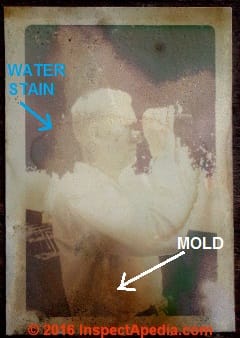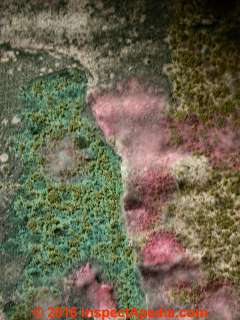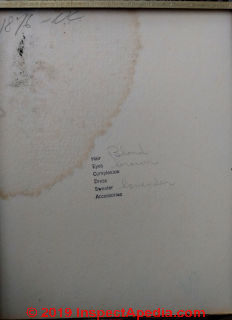 How to Clean Moldy Photographs
How to Clean Moldy Photographs
What works, what doesn't, what's dangerous
- POST a QUESTION or COMMENT about the cause, cure, & prevention of reddish-brown foxing stains on books, papers, photographs & similar materials
Mold & mold stains on photographs or photographic prints on paper: how to clean mold off of old photos or paper.
Suggestions for cleaning mold on photographic prints on paper: how to remove mold on photos, what mistakes to avoid. We include list of authoritative references about mold on photographs: cause, cure, and prevention.
This article series defines book & paper foxing - those reddish-brown stains found on some old books, papers, photographs, and other paper products.
We explain the causes of foxing stains, the chemistry and mold components of foxing, and we describe what foxing looks like, how it is cleaned from books, papers, or photographs, and how foxing can best be prevented by book and paper restorers and paper conservators.
InspectAPedia tolerates no conflicts of interest. We have no relationship with advertisers, products, or services discussed at this website.
- Daniel Friedman, Publisher/Editor/Author - See WHO ARE WE?
How to Remove Mold on Photographs
 Question: How do I remove mold from photographs - best & safest ways get mold off of photos
Question: How do I remove mold from photographs - best & safest ways get mold off of photos
(Mar 10, 2016) Anonymous said:
How do I get mold off of photographs?
Mold contaminated photographs: images needed for this article. CONTACT us if you can provide images of moldy photographs that need cleaning & restoration.
Reply:
The object of this moldy photo cleaning procedure is to remove as much mold from the photographs as we can without damaging the photo itself. The object is to remove the mold, not to kill it. To learn why "killing mold" is the wrong approach to mold problems
see MOLD KILLING GUIDE.
Work on a flat surface in a clean, dry, well-ventilated area.
[Click to enlarge any image]
If the volume of moldy materials is significant enough that the worker could be exposed to harmful airborne mold spores, work outside in a clean dry, sheltered area and wear appropriate protective gear such as a HEPA-rated respirator, gloves, goggles.
Professionals work under a hood or in a chamber with negative air pressure. If you have a large quantity of photos or other moldy documents that need cleaning, it's best to hire a professional.
First make sure that the surface of the photo actually has mold or other debris that can be gently wiped away.
In our photo of granddad with binoculars (above) we point out both mold on the lower area of the photograph (white arrow) that may respond to gentle cleaning and a water stain (blue arrow) that won't be removed by wiping.
In general, deeper stains within the photograph emulsion or paper won't be removed by surface cleaning and deserve advice from a photograph conservator or a paper conservator.
We cite some of these sources later in this article.
Avoid aggressive scrubbing that damages the photograph.
Above in the upper left of this photograph: "Commanding Officer (USAF), Orly Airfield, France in 1946" you can see some black smudges that may clean off easily (yellow arrows). But don't start scrubbing away at stains that actually in the paper or beneath the emulsion of the photograph or you'll simply damage or even ruin the photo.
For small areas of mold damage use a cotton swab.
Try working first with dry swabs or wipes to remove all loose surface debris.
Dampening the swab slightly with clean water may assist in surface cleaning.
Watch out: Take care not to damage the photograph itself. For larger areas you may need to use clean cotton cloth as a wipe.
Physically wipe gently to remove surface mold and debris without scratching the photos. Wipe from the center of the photo out towards its edges. Keep folding the wipe to use a clean surface at each wipe.
If you're not sure what mold looks like when it is growing on or in various materials,
see MOLD GROWTH on SURFACES, PHOTOS.
Note: several genera/species of mold and yeasts are growing on the paper surface shown at above/left A photograph whose back is in this condition would best be photo-documented itself as most likely cleaning it is not going to be feasible.
Technical note:
When I set up a field lab to test moldy photos and documents being removed from the basement of a historic NY property managed by the National Park Service I was troubled to find a rather uniform smear of mold over the surfaces of items that had been wiped.
The lesson was that the "mold remediators" were using the same moldy-dirty rag to wipe each item.
You need to think of wiping important surfaces clean as more of a "medical" procedure: use a clean wipe for each item; wipe, fold, wipe with a clean surface, fold, and continue until you need to change to a new wipe because your "clean" square is too small to be useful.
Watch out: do not put a mold-dirty finger in your eye or you might get an eye infection.
Watch out: Breathing high levels of many airborne mold spores including several genera/species commonly found on paper goods and photographs can be dangerous.
Watch out: while vacuum cleaners are often used as a stage in cleaning moldy paper documents, do not use a vacuum cleaner on old photographs as you're likely to scratch and damage the photo. And don't use a vacuum cleaner to clean up the work area either unless it's HEPA rated as you'll simply blow moldy dust around - a possible hazard to occupants and to yourself.
Watch out: Do not use cans of compressed air such as computer-keyboard cleaners to clean old moldy photographs: for the same reason you're not using a vacuum cleaner: you'll be blowing moldy dust around the workspace.
If the photos are kept dry mold growth won't resume but some stains in the paper will. If the photos are valuable I'd take them to a paper conservator for more expert treatment rather than trying the DIY bleach or stain removal techniques discussed above.
There are also special chemicals such as Pec-12 used to clean and restore negatives; other experts use 98% isopropanol (alcohol).
These treatments are for negatives, not for paper-based old photographs; these are not generally designed to clean mold and may be ineffective or worse.
I would be careful to avoid using any liquids (particularly even mold solvents such as spray glass cleaner) on moldy paper prints / or photos as these too may damage the photograph.
Research on Archival Cleaning of Mold on Photographs
- Albright, Gary, and Monique Fischer. "Care of photographs." College and Research Libraries News 58 (1997): 561-564.
- Borrego, Sofía, Alian Molina, and Adriana Santana. "Mold on Stored Photographs and Maps: A Case Study."
- Caldararo, Niccolo, and Candis Griggs. "Preliminary Report on the Conservation of Slides with Special Reference to the Removal of Mold." (2003).
- "Conservation Tip No. 5: Removing mould from records and archives", Archives Outside, New south Wales, Australia, [website] retrieved 2016/07/10, original source: http://archivesoutside.records.nsw.gov.au/conservation-tip-no-5-removing-mould-from-records-and-archives/
- "Emergency Salvage of Moldy Books and Paper", Northeast Document Conservation Center (NEDCC), 100 Brickstone Square, 4th floor Andover, MA 01810-1494 USA Tel: (978) 470-1010, retrieved 2016/07/10, original source: https://www.nedcc.org/free-resources/preservation-leaflets/3.-emergency-management/3.8-emergency-salvage-of-moldy-books-and-paper
- FOXING STAINS on BOOKS & PAPERS - detailed article on identification and advice of foxing stains
- Lee, Mary Wood. Prevention and treatment of mold in library collections with an emphasis on tropical climates: A RAMP study. General Information Programme and UNISIST: United Nations Educational, Scientific and Cultural Organization, 1988.
- Patkus, Beth Lindblom, and M. A. Walpole. "Emergency salvage of moldy books and paper." Preservation of Library & Archival Materials (1999).
- Remple, Siegfried. "The Conservation of Case Photographs." Archivaria 1, no. 3 (1976).
- Thurn, Jim. "Research on Methods to Remove Mold from Cellulose Acetate Audiotape." (2006).
- Walsh, Betty. "Salvage operations for water damaged archival collections: A second glance." (1997).
- Wood Lee, Mary. "Prevention and Treatment of Mold in Library Collections with an Emphasis on Tropical Climates: A Ramp Study." (1988).
- American Institute for Conservation of Art and Historic Artifacts (AIC), 1717 K Street NW, Suite 200, Washington, DC 20006 Phone 202-452-9545 Website: http:/aic.stanford.edu/
- [1] Book Conservation, Department of Preservation & Collection Maintenance, Cornell University Library, Website: http://www.library.cornell.edu/preservation/operations/bookconservation.html - quoting:
Conservation staff will advise and assist the public with regard to water, mold or insect damage and offer advice on storage and environment. The book conservation unit is a resource for libraries, organizations, and individuals outside Cornell.
The following book preservation publications are available to the public at the Cornell University Library website: http://www.library.cornell.edu/preservation/publications/index.html- Air Drying of Wet Books, Cornell University pamphlet, gives critical advice on how to handle books that have been wet. Original source: http://www.library.cornell.edu/preservation/publications/documents/AirDryingofWetBooks.pdf
- Disaster Response Plan, Cornell University Library, Disaster Subcommittee, Department of Preservation and Collection Maintenance, Security and Library Safety Working Group, Cornell University Library, Ithaca, NY 14583, Rev. July 2006.
Includes advice on preserving books following a disaster, storm, water, etc. including book drying and book cleaning methods following a water or flood disaster. - Pigment Particle & Fiber Atlas for Paper Conservators, Claire McBride, Getty Trust Postgraduate Fellow 2002, see http://www.library.cornell.edu/preservation/publications/mcbride.html [draft, incomplete, unedited] includes pigment atlases for Eastern pigments and fibers, Western pigments and fibers, and combined sources.
- Preserving Books in Your Home Library, Cornell University Library, original source: http://www.library.cornell.edu/preservation/publications/PreservingBooks.pdf
- [2] Book Conservation Internship Program, U.S. Library of Congress, see http://www.loc.gov/preserv/int_book.html
- Canadian Conservation Institute (CCI), 1030 Innes Road, Ottawa ON K1A 0M5, Canada, Tel: 613-998-3721, Website: http://www.cci-icc.gc.ca/html/
- Conservation on Line (CoOL), http://palimpsest.stanford.edu/
- [3] Frost, Gary, Teaching Book Conservation Methods Within a Training Program, The Book and Paper Group Annual, Vol. Five 1986, Book & Paper Specialty Group, AIC, Chicago 1986. Gary Frost, Asst. Professor, School of Library Service, Columbia University. Web-search 02/23/2011, original source: http://cool.conservation-us.org/coolaic/sg/bpg/annual/v05/bp05-13.html
- [4] Godsey, Joyce, Book Repair for Booksellers: A Guide for Booksellers offering practical advice on book repair, CreateSpace (April 22, 2009), ISBN-10: 1442137320, ISBN-13: 978-1442137325 [author is a bookseller trained in book conservation and repair].
- [5] Greenfield, Jane, The Care of Fine Books, Skyhorse Publishing; Reprint edition (September 1, 2007), ISBN-10: 1602390789, ISBN-13: 978-1602390782. Quoting from Amazon.com product description:
Jane Greenfield, advisor in rare book conservation at Yale University Library, is a leading authority on preservation and repair. After attending the New York School of Applied Design, she operated her own bindery for several years, enabling her to write from an unusual level of both education and experience.
Here she offers a concise yet thorough discussion of book construction, storage, handling, cleaning, and repair, as well as essential expert advice on how to properly store and handle books of value in order to protect them from fire, flood, theft, and common wear and tear.
With a new introduction by bestselling author Nicholas A. Basbanes, this is an indispensable volume for bibliophiles of every description. - [6] Guild of Book Workers, 521 Fifth Avenue, New York, NY 10175-0038, National Organization for all the Book Arts, Website: http://guildofbookworkers.org/
- Heritage Preservation (HP), 1012 14th Street, NW Suite 1200, Washington, DC 20005, Tel: 202-233-0800, Website: http://www.heritagepreservation.org/
- [7] Johnson, Arthur W., The Practical Guide to Book Repair and Conservation , [may not be available]
- [8] Lavender, Kenneth, Book Repair: A How-to-Do-It Manual (How-to-do-It Manuals for Libraries, No. 107) (How to Do It Manuals for Librarians) , Neal-Schuman Publishers; 2 Sub edition (February 1, 2001), ISBN-10: 1555704085, ISBN-13: 978-1555704087 - Quoting:
Lavender's highly acclaimed guide has been completely revised and expanded to offer up-to-date help. Covering both basic book repair techniques and sound conservation practices, this completely revised step-by-step manual offers illustrated sections on cleaning, mending, hinge and spine repair, strengthening paperbacks, and more. Completely new chapters cover: wet and water-damaged books; mold and mildew; repair of book linings and pamphlet bindings; using acid-free materials to repair damaged books; lining paper objects; affordable repair tools and supplies and much more.
A full discussion of when and how to make repairs, and alternative conservation practices that enable each librarian to develop procedures appropriate to his or her library are also provided. Here is the practical guidance you need to successfully perform archivally-sound repairs - even on a limited budget. - [9] McQueen, Sharon, Latorraca, Ellen, Warmbold, Richard, In-House Bookbinding and Repair, The Scarecrow Press, Inc. (September 26, 2005, ISBN-10: 0810852241, ISBN-13: 978-0810852242, Quoting:
In-House Bookbinding and Repair is a working document that contains information on setting up both a basic bookbindery and repair lab (i.e. the design, equipment, tools, and supplies needed) and instructions on rebinding and repairing cloth-bound books. Highly illustrated to greater enhance its usefulness, this manual also covers various aspects of book repair and conservation, and contains appendixes on manufacturers and suppliers of materials and products discussed in the text, an extensive Glossary of terms, a separate section on World Wide Web Resources, and a helpful bibliography.
This manual will prove valuable to libraries of all sizes and locations. - National Park Service (NPS), Conserve-O-Gram [museum management series], Website: http://www.cr.nps.gov/
- NEDCC, "Preservation of Library & Archival Materials: A Manual", Northeast Document Conservation Center (NEDCC), 100 Brickstone Square, Andover, MA 01810-1494, Tel: 978-475-6021 Website: http://nedcc.org/
- [10] Rosenberg, Margot, Marcowitz, Bern, The Care and Feeding of Books Old and New, St. Martin's Griffin (March 1, 2004), ISBN-10: 0312326033, ISBN-13: 978-0312326036. [Authors are owners of Manhattan's Dog Lovers' Bookshop]
- [11] Schecter, Abraham A., Basic Book Repair Methods,
- [12] Swifter Sweeper Dry Sweeping Cloths, Unscented>, [at Amazon, also at grocery stores, cleaning suppliers] [ Note: Amazon pays us a small pittance when items are purchased through the link above - Ed.]
- Also seeReferences or Citations for this article
Question: Digital image cleanup as an alternaive to repairing mold & water stainined photographs
2019/12/05 Anonymous asked (by private email)
In your article you requested examples of moldy photographs. Here is an example. I would welcome any direction as to how to best clean it.
[Click to enlarge any image]
Reply:
 Typically you'd dry the photos, then using a soft cloth to avoid scratching the finished photo side, gently wipe away actual loose mold and other dust or particles.
Typically you'd dry the photos, then using a soft cloth to avoid scratching the finished photo side, gently wipe away actual loose mold and other dust or particles.
If the white area in the upper right of the photo image is actual loss of pigmented ink from the paper, you'd need to follow photo restoration re-coloring using a suitable pigmented ink or marker to try to replace the lost colors.
For non-historical documents (in which preservation of the actual original is of historic import and value).
What I do that works very well on photos like yours - if not of historic value - is to make a new digital image of the original photo,
then using a simple photo editor, even microsoft paint, I copy and fill with a closely-matched color from nearby areas of the same photo.
I will demonstrate that with a "doctored" version of your example photo here. This is a very quick and technically-incomplete pass just to illustrate how easily this image can be repaired.
Using a simple Paint program I spent less than 5 minutes on the digitally re-touched photos you see here.
Digital repair of the mold and water damaged original is far less expensive than having a restoration conservator repair the original.
The article above has a more-complete list of suggestions and research than I could re-type off-the-cuff here.
Please take at the article and references above on this page and don't hesitate to ask follow-up questions.
What about cleaning the back of the photo?
In my opinion it's not necessary to remove stains from the back of the photo but it is important to be sure the paper is dry and that any mold that can be physically removed is so treated.
Once the photo is dry and physically clean, if you keep it dry mold will not re-grow in or on the paper.
Should We Completely Restore Old Photographs?
Well sometimes, yes. But in cleaning up this 120 year old photograph of my grandmother, Hannah Denekamp, I preferred to just reduce the terrible gash across grandma and to leave other indicators of the photograph's age.
The before (above) and after (below) photos are an example of simple digital re-touching that is quick and easy.
...
Continue reading at FOXING STAINS on BOOKS & PAPERS or select a topic from the closely-related articles below, or see the complete ARTICLE INDEX.
Or see these
Art, Book, Document, Photogaph Foxing & Mold Articles
- AEROBIOLOGY ASSOCIATIONS
- ART CONSERVATION - Cultural Heritage and Aerobiology
- ARTWORK MOLD CONTAMINATION
- BIODETERIORATION AGENT & STAIN CATALOG
- BLACK LIGHT & UV LIGHT USES
- BOOK / DOCUMENT MOLD & WATER DAMAGE RESTORATION
- PREPARE TO CLEAN BOOKS / PAPERS
- HEALTH HAZARDS, MOLDY BOOKS
- DUST, TYPICAL LIBRARY SHELF CONTENTS
- BOOK-MOLD CLEANUP for DO-IT-YOURSELFers
- MAGAZINE MOLD CLEANUP for DO-IT-YOURSELFers
- MILDEW on BOOKS? - no, it's NOT mildew.
- BOOK CONSERVATION RESOURCES
- FOXING STAINS on BOOKS & PAPERS
- MILDEW ERRORS, IT's MOLD
- MILDEW PHOTOGRAPHS BUILDINGS ?
- MILDEW REMOVAL & PREVENTION
- MILDEW on BOOKS?
- MILDEW ERRORS, IT's MOLD
- MILDEW in or on PAINT
- MILDEW PHOTOGRAPHS
- PAPAYA WHITE GROWTH vs DISEASE
- MOLD on PHOTOGRAPHS, CLEAN-UP
Suggested citation for this web page
MOLD on PHOTOGRAPHS, CLEAN-UP at InspectApedia.com - online encyclopedia of building & environmental inspection, testing, diagnosis, repair, & problem prevention advice.
Or see this
INDEX to RELATED ARTICLES: ARTICLE INDEX to MOLD CONTAMINATION & REMEDIATION
Or use the SEARCH BOX found below to Ask a Question or Search InspectApedia
Ask a Question or Search InspectApedia
Try the search box just below, or if you prefer, post a question or comment in the Comments box below and we will respond promptly.
Search the InspectApedia website
Note: appearance of your Comment below may be delayed: if your comment contains an image, photograph, web link, or text that looks to the software as if it might be a web link, your posting will appear after it has been approved by a moderator. Apologies for the delay.
Only one image can be added per comment but you can post as many comments, and therefore images, as you like.
You will not receive a notification when a response to your question has been posted.
Please bookmark this page to make it easy for you to check back for our response.
Comments
IF above you see "Comment Form is loading comments..." then COMMENT BOX - countable.ca / bawkbox.com IS NOT WORKING.
In any case you are welcome to send an email directly to us at InspectApedia.com at editor@inspectApedia.com
We'll reply to you directly. Please help us help you by noting, in your email, the URL of the InspectApedia page where you wanted to comment.
Citations & References
In addition to any citations in the article above, a full list is available on request.
- [13] HEPA Vacuum Cleaners, HEPA-Rated [at Amazon.com - Note: Amazon pays us a small commission on purchases through this store]
- C-Backpack HEPA 10 Q Vacuum Cleaner - HEPA (recommended for professional and large project book and library cleanup projects)
- Dustless Technologies 6-gallon HEPA Vacuum Cleaner (small shop vac size)
- Eureka 2694F Pet Lover Mighty Mite (floor canister - may be suitable for book cleaning)
- Eureka 4870MZ Boss Smart-Vac Upright HEPA< acuum Cleaner (upright)
- Hoover Platinum Upright Lightweight Vacuum Cleaner - HEPA (upright)
- Rigid WD1450 14-BGallon 6-HP Wet/Dry Vac - HEPA shop vac size), may be too powerful?
- Sunpentown V-8506 Bagless Upright Vacuum Cleaner (upright)
- [14] Verheyen, Peter D., Basic Paper Treatments for Printed Book Materials, presentation, Guild of Book Workers 9th Anniv. Seminar, Portland OR, 1989, web search 02/23/2011, original source: http://www.philobiblon.com/gbwarticle/gbwjournalarticle.htm Quoting:
Since these presentations and the synopses that later appeared in the GBW Newsletter, there has been some discussion. The presentations and these articles are not to be construed as a "how to" of basic paper conservation but rather as an introduction for those with interest but little experience. For the more experienced, they present the methods of the individual conservator for dealing with common problems. None of these methods is the only way to carry out a specific treatment. Each project has its own challenges and no two are alike. It is therefore important to continue to build our knowledge through both reading and the lessons of experience. - [15] Thanks to reader Mike Olsen for discussing the problem of how a lab can determine whether or not mold in a test sample is active or inactive - June 2010
- [16] Zotti (2011): M. Zotti, A. Ferroni, P. Calvini, "Mycological and FTIR analysis of biotic foxing on paper substrates", International Biodeterioration & Biodegradation
Volume 65, Issue 4, July 2011, Pages 569–578, [copy on file as Zotti_2011.pdf]
Abstract The small rusty stains (foxing) frequently found on historic paper documents, books, and prints have generally been analysed in the past by optical microscope through their morphochromatic appearance under visible light and UV radiation. Despite increased research efforts with more sophisticated techniques (mainly SEM and XRF), the biotic or even chemical origin of these stains remains unclear. The purpose of this paper is to verify to what extent a simple technique such as FTIR-ATR spectroscopy can be utilised for a clearer understanding of the controversial nature of foxing. Since this technique is sensitive to several organic chemical groups that are in common with both fungi and gelatine-sized ancient paper, some modern cardboards stained by biotic foxing have been selected for the analyses. The results clearly show the importance of FTIR and mycological analyses for the identification of residual microfungal agents, together with the by-products of their activity on paper substrates. Keywords: Archaeometry; Foxing; Moulds; Fungi; Paper biodeterioration; Paper composition. Corresponding author. Tel.: +39 0103099378; fax: +39 0102099377. Email: milla@klaatu.com.dist.unige.it - [17] Zotti (2008): Zotti, Mirca,Ferroni, Alice, Calvini, Paolo, "Inhibition Properties of Simple Fungistatic Compounds on Fungi Isolated from Foxing Spots", Restaurator [Restaurator. International Journal for the Preservation of Library and Archival Material] Volume 28, Issue 3, Pages 201–217, ISSN (Print) 0034-5806, DOI: 10.1515/REST.2007.201, April 2008, online publication, Summary:
Only few solvents and chemical compounds are employable for the reduction of acidity and fungi in aged paper documents. In this study, we tested the fungistatic properties of calcium propionate (already proposed as deacidificant) either in aqueous or ethanolic solution. Further, we compared the effect of this treatment with that of a commercially available fungistatic spray based on 4-hydroxybenzoate and propyl 4-hydroxybenzoate. One set of tests was performed on fungi isolated from foxed old paper samples. Another was performed on a sheet of glass that had recently covered a cardboard backing in a frame and that showed a one-to-one correspondence between the spawn on the glass and the foxing stains on cardboard. Ten species representative of filamentous fungi genera and one yeast form were identified. Of the fungal species, the one most frequently represented was Penicillium, with 5 different strains, while for each of the other genera there was only one species. The antifungal chemicals investigated presented different levels of effectiveness in inhibiting micro-organism growth: the results of a number of tests carried out on strains cultured in suitable media demonstrate that saturated solutions (3.5 g/L) of calcium propionate in ethanol significantly inhibit the fungal growing. - [17a] Zotti (2008): M. Zotti, A. Ferroni, P. Calvini, Microfungal biodeterioration of historic paper: preliminary FTIR and microbiological analyses International Biodeterioration and Biodegradation, 62 (2008), pp. 186–194
- [17b] Zotti (2007): Zotti, M., Ferroni, A., Calvini, P., 2007. Foxing biologico: diagnostica multidisciplinare. In: Atti del V Congresso Nazionale IGIIC e Lo stato dell’Arte e Cremona, 11e13 Ottobre 2007. Nardini Ed, Firenze, pp. 267e272.
- [18] Book Repair Guide, Bookcraft®, supplier of book, paper & photograph conservation and restoration supplies; archival storage advice, Tel. 1-800-448-6160 Website: www.gaylord.com, retrieved 9/1/12, original site http://www.gaylord.com/images/Bookcraft_BookRepairGuide.pdf, [copy on file as Bookcraft_BookRepairGuide.pdf] and sources recommended by Gaylord:
- [19] Banks, Paul N. & Pilette, Roberta, Eds., Preservation Issues and Planning, Chicago and London: American Library Association, 2000
- [20] Lavender, Kenneth and Stockton, Scott. Book Repair: A How-To-Do-It Manual, for School and Public Libraries. 2nd ed. New York: Neal Schuman, 2001
- [21] Lull, William P. with Banks, Paul N. Conservation Environment Guidelines for Libraries and Archives. Ottawa: Canadian Council of Archives, 1995, from the Canadian Council of Archives, 3444 Wellington St., Room 1009, Ottawa, Canada K1A 0N3
- [22] Ogden, Sherelyn, Editor. Preservation of Library & Archival Materials: A Manual. 3rd ed. Andover, MA: Northeast Document Conservation Center, 1999 (technical leaflets available online at www.nedcc.org)
- [23] Preservation of Library & Archival Materials: A Manual. 3rd ed. Andover, MA, Northeast Document Conservation Center, 1999
- [24] Young, Laura. Bookbinding & Conservation by Hand. Reprint edition. Newark, Delaware: Oak Knoll Press, 1995
- [25] Tronson, Paul, "Removing Foxing and Mildew", Bookbinding & Royal Bindings-Commissions Accepted-Worldwide, Canada, Email: paul@periodfinebindings.com, Tel: +1 250 580 1547, retrieved 9/11/12, original source: http://periodfinebindings.typepad.com/removing_foxing_and_milde/ [copy on file as Removing_Foxing_Tronson.pdf]
- [26] Coleman, M.H.; Baynes-Cope, A.D.; Agabeg, R.C., "Foxing", Chemistry and industry, Vol. 7, February 15, 1969, p. 197, three letters to the editor, quoting:
Watch out: as we note below, the following advice is out of date and dangerous. Do not follow it for removing foxing stains. Rather we repeate it here only so that readers can recognize these procedures that should not be followed:
These three letters to the editor discuss removal of foxing stains from philatelic materials. Coleman recommends, in order of increasing severity, immersion in solutions of 1) 0.25% washing soda, 2) 2% chloramine T, 3) 2% sodium chlorite with 2.5% formalin, or 4) 5% potassium permanganate followed by 2% oxalic acid. Paper requires re-sizing. Baynes - Cope recommends early detection by ultra violet (UV) light, and removal by oxidative bleaching in hypochlorites. Test for color sensitive materials (eg. manuscript inks) or gums. Prevent foxing (microbiological attack) by maintaining humidity (RH) at 50-60% with good ventilation (air circulation), or interleaving pages with paper impregnated with orthophenyl phenol fungicide or its' sodium salt. Agabeg describes treatment of stamps using 1-5% chloramine T. Color sensitivity should be tested using a blank. Loss of original gum will reduce a stamp's value. This article is a reference for the conservation of library, archival and philatelic materials, and works of art (eg. prints, drawings) on paper.
Watch out: As Calvini has explained at FAQs,
The reccommendation after Coleman [shown just above] are out-to-date and potentially very dangerous: should not be described in detail in Inspectapedia, otherwise not trained people may apply them in a blind way, as they find only this receipt fully described.
- [27] E. Sarantopoulou [Email: esarant@eie.gr] , S. Kobe,Z. Kollia, A.C. Cefalas, "Removing foxing stains from old paper at 157 nm", Applied Surface Science,
Volumes 208–209, 15 March 2003, Pages 311–316, Physics and Chemistry of Advanced Laser Materials Processing,
Abstract: Using a molecular fluorine laser at 157 nm foxing stains were removed successfully from a 16th century old paper. Laser cleaning of stains and foxing from old paper manuscripts is far more effective at 157 nm in comparison to different wavelengths without leaving any yellowish after-effect on the paper. This is because at 157 nm illumination of old paper, complete bond breaking of all the organic molecules of the paper is taking place. Mass spectroscopy at 157 nm and for moderate laser intensities up to 1 mJ/cm2 of old paper suffering from foxing indicate organic matter disintegration to small photofragments atomic, diatomic or triatomic, which are flying apart with supersonic speed. In addition high spatial resolution energy dispersive X-ray system (EDXS) analysis over the effected areas indicate the presence of iron, suggesting that biological activity is taking place preferentially in paper areas containing iron. - [28] S. Sequeira, E-mail: , E.J. Cabritab, M.F. Macedoc, "Antifungals on paper conservation: An overview", International Biodeterioration & Biodegradation
Volume 74, October 2012, Pages 67–86,
Abstract & Highlights: Since its invention, paper has become one of the main carriers of our cultural, scientific, political, economic and historical information. Given the importance of this material, its preservation is a matter of great interest. Paper can be deteriorated due to physical, chemical and biological agents. Within microorganisms, fungi are the major paper biodeteriogens. Throughout history, several methods have been used to prevent and stop fungal deterioration on paper based materials. In this work we present a review of the main chemical and physical methods used to avoid fungal paper biodeterioration until nowadays and also of some new approaches tested recently. The advantages and disadvantages of these methods are discussed as well as their health effects. Studies regarding antifungal compositions, methods of application, performance and effects on the treated materials are also presented with the aim of providing a clear set of conclusions on the topic.
The use of antifungals on paper conservation is reviewed. Performance and effects on the treated materials of each antifungal method are discussed. The advantages and disadvantages of the antifungal methods are compared. Composition, methods of application and health effects are described. Two tables summarizing the results are presented. - [29] Sabrina Manente Email: manente@unive.it, Anna Micheluz, Renzo Ganzerla, Giampietro Ravagnan, Andrea Gambaro, "Chemical and biological characterization of paper: A case study using a proposed methodological approach", International Biodeterioration & Biodegradation, Volume 74, October 2012, Pages 99–108,
Abstract: One of the most important causes of paper degradation is biodeterioration, caused especially by fungi and bacteria under certain environmental conditions. This study was designed to check the presence of cellulolytic microorganisms on documents from the 19th century, and to verify any biodeterioration that may have occurred by using a series of predominantly non-invasive analyses in order to preserve their integrity. For the characterization of paper documents various non-destructive micro-analyses were performed in succession, so as to deepen our knowledge of these step by step and thus provide a logical approach for the general study of this type of artifact. The samples were analyzed by using light microscopy, histochemical tests, pH analysis, SEM–EDS observations, Fourier transform infrared (FTIR) spectroscopy in ATR, and GC–MS. Organic cultures were also made with the samples taken from the surfaces of the documents; in particular, four fungal species, Aspergillus sp., Penicillium sp., Cladosporium sp., and Ulocladium alternarie, have been identified, as well as the presence of bacteria and dust mites. Finally, relations/correlations between the results of chemical and biological analyses are discussed.
Highlights: The biodeterioration of paper is caused especially by cellulolytic fungi and bacteria. Characterization of paper documents with non-destructive micro analyses. SEM–EDS, FT-IR in ATR, GC–MS and organic cultures. Isolated: Aspergillus sp., Penicillium sp., Cladosporyum sp., Ulocladium alternarie. - [30] High Definition Infra Red, The Truth About What You Thought You Knew, FLIR Systems, Inc., 27700 SW Parkway Ave., Wilsonville OR 97070, USA, Tel: 800-727-3547, Website: www.FLIR.com, retrieved 9/11/12, original source: http://gs.flir.com/uploads/file/white-papers/hd-infrared.pdf [copy on file as FLIR_hd-infrared.pdf]
- [31] Arai, H., 1984. Microbiological studies on the conservation of paper and related cultural properties: Part 1, isolation of fungi from the foxing on paper. Science for Conservation 23, 33e40.
- [32] Arai, H., 1987. On the foxing-causing fungi. Preprints of the ICOM Committee for Conservation.
- [33] Arai, H., 2000. Foxing caused by fungi: twenty five years of study. International Biodeterioration and Biodegradation 46, 181e188.
- [34] Arai, H., Nemoto, C., Matsui, N., Matsumura, N., Murakita, H., 1989. Microbiological studies on the conservation of paper and related cultural properties: Part 8, on the components found in foxing. Science for Conservation 28, 7e15.
- [35] Meynell, Guy, "Notes on Foxing, Chlorine Dioxide Bleaching and Pigments", Paper conservator, ISSN 0309-4227, Vol 4, No. 1, 01/01/1979 p. 30
- [36] Henry A. Carter, The Chemistry of Paper Preservation: Part 1. The Aging of Paper and Conservation Techniques, Journal of Chemical Education 1996 73 (5), p 417
Abstract: This study provides an introduction to the problem of the aging of paper and the conservation techniques that are currently being employed in paper preservation. The chemical reactions that are responsible for the aging of paper are discussed with the conclusion that acid-catalyzed hydrolysis is the predominant mechanism for cellulose degradation and strength loss. A description and the chemistry of a number of mass deacidification methods are presented. The more viable deacidification methods include the DEZ, Wei T'o, FMC, Bookkeeper, Viennese, Book Preservation Associates, Sable and the Batelle processes. A summary of the literature on the evaluations of these processes is presented, and the benefits and limitations of the mass deacidification methods are discussed. Other conservation techniques such as paper strengthening, conservation bleaching, and pest control are briefly introduced, followed by an introduction to alkaline papermaking. - [37] Henry A. Carter, The Chemistry of Paper Preservation: Part 2. The Yellowing of Paper and Conservation Bleaching, J. Chem. Educ., 1996, 73 (11), p 1068
DOI: 10.1021/ed073p1068, November 1, 1996
Abstract: The discoloration of paper on aging is of interest to the archival community and also to the pulp and paper industry where new and improved mechanical pulps are being developed. The yellowing of paper on aging can be attributed to the presence of chromophores found in some of the products formed from the degradation of one or more components of paper. This study identifies the nature of the chromophores found in cellulose, hemicellulose and lignin. The photooxidation of lignin-containing papers and the mechanism for photoyellowing are discussed. This is followed by a description of the basic principles of conservation bleaching which involves chemically treating papers in order to remove unwanted discoloration or stains. The washing of paper and the use of oxidizing and reducing bleaches are presented. The discussion on oxidizing bleaches includes hydrogen peroxide, alkaline hypochlorite, chlorine dioxide and sunlight. The chemistry of reducing bleaches focuses on dithionites and borohydrides. - [38] Henry A. Carter, The Chemistry of Paper Preservation Part 3. The Strengthening of Paper, Journal of Chemical Education 1996 73 (12), p 1160
Abstract: The following study describes the parylene and graft copolymerization processes that have been developed to strengthen fragile or brittle paper artifacts. The parylene process involves vaporizing di-para-xylylene at 150o - 250 oC and splitting the dimeric parylene gas at 650o - 690 oC to mono-para-xylylene. The monomer vapor collides with the surface of the paper sample at room temperature and penetrates the cellulose fibers. Polymerization of the monomeric units to poly- para-xylylenes then occurs with the deposition of a thin uniform film. This parylene film forms mechanical links with broken fibers and strengthening occurs. The graft copolymerization (British Library) method involves treating papers with gaseous monomeric ethyl acrylate and methyl methacrylate, and initiating copolymerization by irradiating the papers with low intensity gamma rays. Webs of long-chained polymers are deposited on and between the cellulose fibers thereby strengthening the papers. The chemistry as well as modifications to both processes are discussed. - [39] Henry A. Carter, The Chemistry of Paper Preservation: Part 4. Alkaline Paper, Journal of Chemical Education1997 74 (5), 508
Abstract: The inherent instability of old papers is largely due to the presence of acids which catalyze the hydrolytic degradation of cellulose. The use of alkaline paper can minimize the problem of acidity for new papers. This study focuses on the chemistry involved in the sizing of both acid and alkaline papers and the types of fillers used. The waterproofing agent that is used in acid paper is alum-precipitated rosin size, which tends to spread and create a hydrophobic surfaces over the cellulose fibers. Alkaline paper uses the synthetic sizing agents, alkyl ketene dimers(AKD) and alkyl succinic anhydrides (ASA). These alkaline sizing agents become chemically bound to the cellulose fibers with hydrophobic chains pointing outward, producing a water repellent surface. The sizing reactions take place in a neutral-to-alkaline medium. Calcium carbonate can then be used as a filler to replace expensive titanium dioxide. Finally, the advantages and potential problems in alkaline paper making are discussed. - [40] Henry A. Carter, The Chemistry of Paper Preservation. Part 5. Permanent Paper
Journal of Chemical Education 2007 84 (12), 1937
Abstract: The acid-catalyzed hydrolysis of cellulose accounts for the deterioration of paper in library books and other written records. To combat this threat to our written heritage, new permanent papers have been developed that are relatively chemically stable and undergo a very slow rate of deterioration. Many of these new papers are manufactured from mechanical pulps that contain large amounts of lignin, and are stable when a calcium carbonate buffer is present. Based on the performance involving accelerated aging of the papers, the inclusion of lignin has been accepted in the standards for permanent paper by Canada and Germany, providing that a calcium carbonate buffer is present. Other countries are still reluctant to make the change in standards to include lignin. Research needs to be done to define optical properties and their requirements for the standards. The applications of the chemistry of paper preservation to teaching are also discussed. - In addition to citations & references found in this article, see the research citations given at the end of the related articles found at our suggested
CONTINUE READING or RECOMMENDED ARTICLES.
- Carson, Dunlop & Associates Ltd., 120 Carlton Street Suite 407, Toronto ON M5A 4K2. Tel: (416) 964-9415 1-800-268-7070 Email: info@carsondunlop.com. Alan Carson is a past president of ASHI, the American Society of Home Inspectors.
Thanks to Alan Carson and Bob Dunlop, for permission for InspectAPedia to use text excerpts from The HOME REFERENCE BOOK - the Encyclopedia of Homes and to use illustrations from The ILLUSTRATED HOME .
Carson Dunlop Associates provides extensive home inspection education and report writing material. In gratitude we provide links to tsome Carson Dunlop Associates products and services.









No one has commented yet. Be the first!